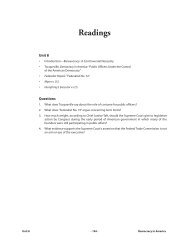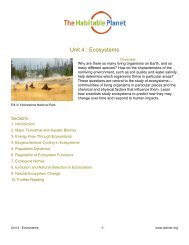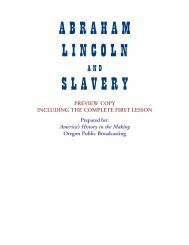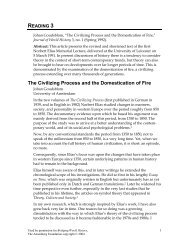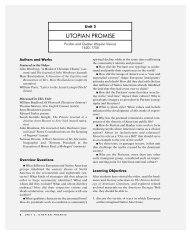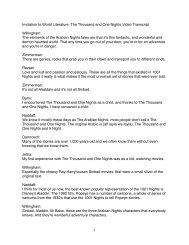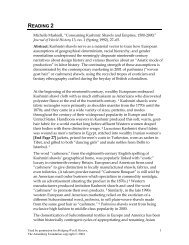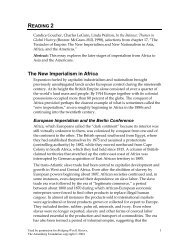Trade, Technology, and Culture: The Mali Empire in West Africa
Trade, Technology, and Culture: The Mali Empire in West Africa
Trade, Technology, and Culture: The Mali Empire in West Africa
You also want an ePaper? Increase the reach of your titles
YUMPU automatically turns print PDFs into web optimized ePapers that Google loves.
READING 1<br />
C<strong>and</strong>ice Goucher, Charles LeGu<strong>in</strong>, <strong>and</strong> L<strong>in</strong>da Walton, “<strong>Trade</strong>, Transport,<br />
Temples, <strong>and</strong> Tribute: <strong>The</strong> Economics of Power,” <strong>in</strong> In the Balance: <strong>The</strong>mes <strong>in</strong><br />
Global History (Boston: McGraw-Hill, 1998), 231–45.<br />
Abstract: This essay explores the material conditions that gave rise to<br />
<strong>in</strong>creas<strong>in</strong>gly centralized, hierarchical social organizations between the 13 th<br />
<strong>and</strong> 15 th centuries. In particular, it focuses on two empires <strong>in</strong> very different<br />
parts of the world: the <strong>Mali</strong> <strong>Empire</strong> <strong>in</strong> <strong>West</strong> <strong>Africa</strong>, <strong>and</strong> the Mongol <strong>Empire</strong> <strong>in</strong><br />
Eurasia. Of central importance are the ways <strong>in</strong> which military conquest, trade,<br />
<strong>and</strong> technology aided the development of these empires.<br />
<strong>Trade</strong>, <strong>Technology</strong>, <strong>and</strong> <strong>Culture</strong>: <strong>The</strong> <strong>Mali</strong> <strong>Empire</strong> <strong>in</strong> <strong>West</strong><br />
<strong>Africa</strong><br />
Of the numerous empires that developed <strong>and</strong> disappeared on the <strong>Africa</strong>n<br />
cont<strong>in</strong>ent, <strong>Mali</strong> was one of the first south of the Sahara to capture the<br />
attention of both the Islamic <strong>and</strong> European worlds. <strong>Mali</strong> also illustrates the<br />
range <strong>and</strong> diversity of historical sources, written <strong>and</strong> nonwritten, that may be<br />
brought to bear on the reconstruction of empires. <strong>Mali</strong> is an example of an<br />
empire that used culture, ideology, <strong>and</strong> language (M<strong>and</strong>e) to dom<strong>in</strong>ate an<br />
exp<strong>and</strong><strong>in</strong>g territory. <strong>The</strong> grassl<strong>and</strong> <strong>and</strong> semiarid region <strong>in</strong>cluded virtually all<br />
of what was known as the savanna, or “Sudan,” <strong>and</strong> the Sahel, from the<br />
Sahara’s edge to the forest’s edge <strong>in</strong> <strong>West</strong> <strong>Africa</strong>. <strong>The</strong> empire’s manipulation<br />
of technology (iron <strong>and</strong> horses) <strong>and</strong> ecology (beneficial climatic shifts)<br />
emphasizes two of the possible means by which smaller polities may be<br />
<strong>in</strong>tegrated <strong>in</strong>to the structure of a larger empire. At its height <strong>in</strong> the fourteenth<br />
century C.E. the <strong>Mali</strong> <strong>Empire</strong> covered an area greater than 24,000 square<br />
kilometers (9000 square miles), <strong>and</strong> it <strong>in</strong>fluenced, through trade connections,<br />
an even larger portion of <strong>West</strong> <strong>Africa</strong> for several centuries.<br />
Early <strong>West</strong> <strong>Africa</strong>n States <strong>and</strong> the Caravan <strong>Trade</strong><br />
<strong>Mali</strong> was not the first empire to occupy the large grassl<strong>and</strong>s region of <strong>West</strong><br />
<strong>Africa</strong> that straddled the Sahara, the semiarid edge of the desert known as the<br />
“Sahel” (literally the “shore” of the great ocean of s<strong>and</strong>, <strong>in</strong> Arabic) <strong>and</strong> the<br />
<strong>in</strong>l<strong>and</strong> delta of the Niger River. Accord<strong>in</strong>g to oral traditions, the first state <strong>in</strong><br />
that area was known as Ghana by the sixth century C.E. <strong>The</strong>se traditions<br />
suggest that the political unity of ancient Ghana was based on its control of<br />
the very lucrative gold trade of the western Sudan <strong>and</strong> Sahara. Two of the<br />
three major sources of gold, Bambuk <strong>and</strong> Bure, were situated with<strong>in</strong> reach of<br />
the Senegambia region, between the Senegal <strong>and</strong> Gambia Rivers <strong>and</strong> the<br />
<strong>in</strong>l<strong>and</strong> Niger delta.<br />
Used by permission for Bridg<strong>in</strong>g World History, 1<br />
<strong>The</strong> Annenberg Foundation copyright © 2004
Caravans, small parties of merchants, carried goods from one town or<br />
settlement to the next, exchang<strong>in</strong>g southern forest products such as kola nuts<br />
(chewed for their stimulant properties <strong>and</strong> everywhere offered as a symbol of<br />
hospitality), gold, ivory, wood, smoked <strong>and</strong> salted fish, cloth, <strong>and</strong> copper.<br />
<strong>The</strong>se caravans had plied the desert s<strong>and</strong>s for centuries before the rise of the<br />
<strong>West</strong> <strong>Africa</strong>n states. <strong>The</strong> <strong>in</strong>troduction of the camel <strong>in</strong> the second century C.E.<br />
allowed greater regularity of contact than the merchants travel<strong>in</strong>g on foot <strong>in</strong><br />
the earliest centuries of Saharan trade had achieved. By the twelfth century,<br />
<strong>West</strong> <strong>Africa</strong>n gold <strong>and</strong> other products, such as so-called Moroccan leather,<br />
which actually came from the Hausa area of northern Nigeria, were supplied<br />
to Mediterranean markets <strong>and</strong> found their way to the fairs <strong>and</strong> markets of<br />
such places as Norm<strong>and</strong>y <strong>and</strong> Brita<strong>in</strong>. A prolonged series of droughts,<br />
dim<strong>in</strong>ishment of the alluvial sources of gold, <strong>and</strong> repeated attacks by North<br />
<strong>Africa</strong>n peoples try<strong>in</strong>g to control the lucrative caravan trade comb<strong>in</strong>ed to<br />
br<strong>in</strong>g about the dis<strong>in</strong>tegration of Ghana <strong>and</strong> the disruption of trade at the end<br />
of the eleventh century.<br />
In the place of Ghana, the even greater empire of <strong>Mali</strong> developed from the<br />
conquest <strong>and</strong> union of several smaller states. It has been estimated that<br />
dur<strong>in</strong>g the time of the <strong>Mali</strong> <strong>Empire</strong>, <strong>West</strong> <strong>Africa</strong> produced <strong>and</strong> supplied<br />
almost two-thirds of the world’s gold. At its height, the <strong>Mali</strong> <strong>Empire</strong> covered<br />
much of <strong>West</strong> <strong>Africa</strong> <strong>and</strong> <strong>in</strong>corporated <strong>in</strong>to one polity hunters, herders,<br />
nomads, merchants <strong>and</strong> farmers from many different language groups.<br />
Written historical sources, especially the writ<strong>in</strong>gs of Arab scholars, have been<br />
too preoccupied with the wealth of <strong>Mali</strong>. <strong>The</strong> full historical underst<strong>and</strong><strong>in</strong>g of<br />
the empire also relies on archaeological <strong>and</strong> oral sources.<br />
Sunjata <strong>and</strong> <strong>Mali</strong> Oral Tradition<br />
Oral traditions credit a s<strong>in</strong>gle legendary <strong>and</strong> heroic figure with the f<strong>in</strong>al act of<br />
unification: Sunjata, the most powerful of the <strong>Mali</strong> rulers, f<strong>in</strong>ally subjected the<br />
Soso people to the authority of M<strong>and</strong>e languages <strong>and</strong> culture, with the<br />
ascendancy of the Keita clan. <strong>The</strong> praises of Sunjata today are sung by every<br />
griot, or M<strong>and</strong>e oral historian. <strong>The</strong> performance of the griot with<strong>in</strong> M<strong>and</strong>e<br />
society <strong>and</strong> on behalf of the royal clan is an example of how history is used to<br />
legitimize the formation of an empire.<br />
<strong>The</strong> epic of Sunjata devotes a major portion of its tale to sorcery <strong>and</strong> its<br />
relationship to political power. All great exploits, <strong>in</strong>clud<strong>in</strong>g the found<strong>in</strong>g of<br />
empires, require control of the supernatural, or nyama, which the M<strong>and</strong>e view<br />
as both natural <strong>and</strong> mystical energy. Access to sorcery is a component of<br />
political leadership <strong>and</strong> as such is needed to wage successful military<br />
campaigns, to subdue enemies, <strong>and</strong> even to protect one’s personal fortune.<br />
One of the central battles <strong>in</strong> the history of the <strong>Mali</strong> <strong>Empire</strong> is a sorcery war<br />
between Sunjata <strong>and</strong> a rival. Call<strong>in</strong>g on great powers, Sunjata obta<strong>in</strong>ed the<br />
Used by permission for Bridg<strong>in</strong>g World History, 2<br />
<strong>The</strong> Annenberg Foundation copyright © 2004
formula for a substance called nasi, “power of darkness, a th<strong>in</strong>g used to harm<br />
someone.” His griot poured it over the personal objects <strong>and</strong> sources of his<br />
rival’s power, which were duly neutralized, <strong>and</strong> Sunjata triumphed.<br />
Like many <strong>Africa</strong>n div<strong>in</strong>e rulers, Sunjata overcame obstacles, exile, <strong>and</strong> a<br />
physical h<strong>and</strong>icap (the <strong>in</strong>ability to walk from birth) <strong>in</strong> order to demonstrate<br />
his power (nyama). <strong>The</strong> griots generally attribute most of the empire’s<br />
adm<strong>in</strong>istrative structures <strong>and</strong> <strong>in</strong>novations to the reign of Sunjata, who was<br />
probably responsible for the division of the empire <strong>in</strong>to two military regions<br />
<strong>and</strong> for the codification of hereditary craft clans. Dur<strong>in</strong>g <strong>and</strong> after his reign,<br />
blacksmith<strong>in</strong>g, leatherwork<strong>in</strong>g, <strong>and</strong> other specialist activities became<br />
associated with statecraft. <strong>The</strong> products of such activities supported the<br />
expansion of trade <strong>and</strong> empire.<br />
Sunjata’s Capital, Niani<br />
Sunjata rebuilt his capital at Niani, where he ruled for about twenty-five<br />
years, until his death. <strong>The</strong> location of Niani was forgotten for many<br />
generations. Archaeologists recently located the probable site of the <strong>Mali</strong>an<br />
capital of Niani on the Sankarani River, an area rich <strong>in</strong> iron <strong>and</strong> gold. It was<br />
well situated on the forest edge to become the <strong>in</strong>tersection of extensive trade<br />
routes that l<strong>in</strong>ked the different ecological zones of the empire. Excavations<br />
have revealed an Arab quarter <strong>and</strong> a royal villa, as well as stone house<br />
foundations <strong>and</strong> a mosque. Not unlike other well-known <strong>West</strong> <strong>Africa</strong>n<br />
trad<strong>in</strong>g centers, such as Jenne on the Niger, Niani’s royal quarter was<br />
surrounded by dispersed quarters or villages organized for various trades:<br />
smith<strong>in</strong>g, weav<strong>in</strong>g, fish<strong>in</strong>g, leatherwork<strong>in</strong>g. Such concentration of specialist<br />
activities <strong>and</strong> the consequent exchange of goods <strong>and</strong> services controlled by<br />
the centralized authority are classic features of most world empires. <strong>The</strong>ir<br />
formation hav<strong>in</strong>g resulted from conquest, their cont<strong>in</strong>ued control of material<br />
wealth not only cements the <strong>in</strong>corporation of new territories <strong>in</strong>to a s<strong>in</strong>gle<br />
unity but also pays the costs of government.<br />
Accord<strong>in</strong>g to oral tradition, the unification of <strong>Mali</strong> occurred dur<strong>in</strong>g the time<br />
of Sunjata. A popular epic poem records the struggles of Sunjata, the first<br />
<strong>Mali</strong>an k<strong>in</strong>g, <strong>in</strong> a war between Sunjata’s polity <strong>and</strong> several smaller states<br />
about 1220 <strong>and</strong> 1235 C.E. From the time of Sunjata’s victory, the <strong>Mali</strong> <strong>Empire</strong><br />
was cemented by the idea of M<strong>and</strong>e cultural superiority. While praise<br />
s<strong>in</strong>gers, oral historians who sang <strong>and</strong> performed the past, helped to spread<br />
the ideology, blacksmiths <strong>and</strong> others provided the tools of empire. Without<br />
iron weapons <strong>and</strong> leather <strong>and</strong> iron trapp<strong>in</strong>gs for horses, military success<br />
would not have been possible.<br />
Used by permission for Bridg<strong>in</strong>g World History, 3<br />
<strong>The</strong> Annenberg Foundation copyright © 2004
Contemporary Descriptions of <strong>Mali</strong><br />
<strong>The</strong> travels of Mansa Musa (K<strong>in</strong>g Musa), a fourteenth-century ruler of <strong>Mali</strong>,<br />
however, brought attention to the golden wealth of the <strong>Africa</strong>n empire. Like<br />
many of his predecessors, Mansa Musa had eagerly embraced Islam, <strong>in</strong> large<br />
part because of the <strong>in</strong>ternational commercial world the religion opened up.<br />
As the Islamic faith gradually spread across North <strong>Africa</strong> <strong>and</strong> south across<br />
the Sahara (between about 750 <strong>and</strong> 1400 C.E.), it brought merchants <strong>and</strong><br />
clerics, goods <strong>and</strong> ideas. <strong>Mali</strong>, with its capital at Niani not far from the Niger,<br />
became the trad<strong>in</strong>g partner of merchants with connections to <strong>West</strong> Asia <strong>and</strong><br />
beyond. Like any devout Muslim, Mansa Musa was required to attempt the<br />
pilgrimage (hajj) to Mecca, which he did <strong>in</strong> 1325. Accord<strong>in</strong>g to contemporary<br />
accounts, Mansa Musa traveled with thous<strong>and</strong>s of porters <strong>and</strong> servants<br />
bedecked with gold. In Cairo, his generosity <strong>and</strong> wealth were legendary. It<br />
was Mansa Musa who gave away so much gold that he caused the market to<br />
crash <strong>and</strong> depressed world prices. From this time forward, European <strong>and</strong><br />
Arab cartographers depicted the Sudan with portraits of the <strong>Africa</strong>n ruler<br />
hold<strong>in</strong>g a large gold nugget. Yet Mansa Musa is rarely mentioned <strong>in</strong> the oral<br />
tradition. He is remembered for hav<strong>in</strong>g been unfaithful to M<strong>and</strong>e traditions<br />
<strong>and</strong> hav<strong>in</strong>g wasted the imperial treasury.<br />
<strong>The</strong> caravans of gold made the <strong>Mali</strong> <strong>Empire</strong> a celebrated name far beyond<br />
<strong>West</strong> <strong>Africa</strong>. <strong>The</strong> caravan routes met at Niani <strong>and</strong> other stag<strong>in</strong>g posts, <strong>and</strong><br />
their protection was a major function of the empire. Gold, salt, copper, <strong>and</strong><br />
kola nuts were central to <strong>Mali</strong>’s economy. Follow<strong>in</strong>g the reign of Sunjata,<br />
<strong>Mali</strong> became the world’s largest producer of gold. Along with the movement<br />
of material goods went the dissem<strong>in</strong>ation of M<strong>and</strong>e language, technology,<br />
<strong>and</strong> culture. Even later, the empire would serve as the major promoter of<br />
Islamic ideology <strong>and</strong> culture across the <strong>West</strong> <strong>Africa</strong>n savanna.<br />
Ibn Battuta<br />
While the vast majority of written historical sources on the <strong>Mali</strong> <strong>Empire</strong> were<br />
compiled by non-<strong>Africa</strong>ns who rarely set foot <strong>in</strong> <strong>Africa</strong> <strong>and</strong> never ventured<br />
south of the Sahara, an important exception is the eyewitness account by the<br />
Arab traveler Ibn Battuta. Its wealth of detail <strong>and</strong> observation makes his<br />
memoirs, Rihla, an unprecedented portrait of life <strong>in</strong> fourteenth-century <strong>Mali</strong>.<br />
Ibn Battuta was born <strong>in</strong> Tangier, Morocco, <strong>in</strong> 1304. Although he studied law,<br />
he began his celebrated travels as a young man <strong>in</strong> 1326 with the pilgrimage to<br />
Mecca. In the course of his lifetime he journeyed more than 70,000 miles to<br />
Ch<strong>in</strong>a, Southeast Asia, India, East <strong>Africa</strong>, the Niger, <strong>and</strong> the Byzant<strong>in</strong>e<br />
<strong>Empire</strong>. Ibn Battuta considered himself a citizen of the Dar al-Islam, the entire<br />
“abode,” or world, of Islamic civilization. It was through this lens that Ibn<br />
Battuta viewed <strong>Mali</strong> <strong>in</strong> 1352–1353.<br />
Used by permission for Bridg<strong>in</strong>g World History, 4<br />
<strong>The</strong> Annenberg Foundation copyright © 2004
After two months of travel<strong>in</strong>g across the Sahara from Sijilmasa <strong>in</strong> Morocco,<br />
Ibn Battuta’s caravan reached Walata. <strong>The</strong> oldest city of <strong>Mali</strong>, Walata was a<br />
trad<strong>in</strong>g center where Sudanese <strong>and</strong> Berber merchants <strong>and</strong> scholars <strong>in</strong>teracted.<br />
It was here that Ibn Battuta had his first taste of the <strong>in</strong>roads Islam had made<br />
<strong>in</strong>to the <strong>in</strong>tegrity of <strong>Mali</strong>’s <strong>in</strong>digenous ceremonial <strong>and</strong> cultural life. A meet<strong>in</strong>g<br />
with the prov<strong>in</strong>cial governor shocked the visitor, not only because of the<br />
meagerness of his host’s offer<strong>in</strong>g to him of a calabash of millet, honey, <strong>and</strong><br />
yogurt, but because the man, accord<strong>in</strong>g to <strong>West</strong> <strong>Africa</strong>n custom, never<br />
addressed his visitor directly but spoke only through an <strong>in</strong>terpreter.<br />
<strong>The</strong> route between Walata <strong>and</strong> Niani, the <strong>Mali</strong> ruler’s capital, was safe <strong>and</strong><br />
well secured by the adm<strong>in</strong>istrative <strong>and</strong> military controls of the <strong>Mali</strong> <strong>Empire</strong>.<br />
But here, too, Ibn Battuta was shocked by the lack of adherence to orthodox<br />
Islamic custom <strong>and</strong> practice. He wrote of partially clothed women, subjects<br />
who prostrated themselves before the mansa (k<strong>in</strong>g), <strong>and</strong> royal poets who<br />
danced <strong>in</strong> feathers <strong>and</strong> masks, all of which were spectacles outlawed by the<br />
orthodox Islam Ibn Battuta knew. From Ibn Battuta’s account we learn that<br />
although <strong>Mali</strong> officially belonged to the Islamic world <strong>and</strong> thereby had<br />
exp<strong>and</strong>ed the trad<strong>in</strong>g opportunities available to the empire <strong>and</strong> its rul<strong>in</strong>g<br />
elite, it was clear that Islam was to be found only <strong>in</strong> the veneer of <strong>Mali</strong>’s<br />
material life; the underly<strong>in</strong>g substance of <strong>Mali</strong>’s culture was a belief <strong>in</strong> M<strong>and</strong>e<br />
superiority.<br />
Grow<strong>in</strong>g Inequalities <strong>in</strong> the <strong>Mali</strong> <strong>Empire</strong><br />
Another important feature of the <strong>Mali</strong> <strong>Empire</strong> that we learn from Ibn Battuta<br />
is how much social <strong>in</strong>equality existed. One of the consequences of the<br />
expansion of empire through trade <strong>and</strong> military means was the capture of<br />
prisoners of war, who then became sources of male soldiers <strong>and</strong> female<br />
slaves. <strong>The</strong> Sahelian <strong>and</strong> Saharan towns of the <strong>Mali</strong> <strong>Empire</strong> were organized as<br />
both stag<strong>in</strong>g posts <strong>in</strong> the long-distance caravan trade <strong>and</strong> trad<strong>in</strong>g centers for<br />
the various <strong>West</strong> <strong>Africa</strong>n products. At Taghaza, for example, salt was<br />
exchanged; at Takedda, copper. Ibn Battuta observed the employment of<br />
slave labor <strong>in</strong> both towns. Dur<strong>in</strong>g most of his journey, Ibn Battuta traveled<br />
with a ret<strong>in</strong>ue that <strong>in</strong>cluded slaves, most of whom carried goods for trade but<br />
would also be traded as slaves. On the return from Takedda to Morocco, his<br />
caravan transported 600 female slaves, suggest<strong>in</strong>g that slavery was a<br />
substantial part of the commercial activity of the empire’s fr<strong>in</strong>ges.<br />
Gender Divisions<br />
<strong>The</strong>re were many more female slaves than male slaves traded <strong>in</strong> the empire, a<br />
fact that po<strong>in</strong>ts out the <strong>in</strong>equality that existed between the genders. <strong>The</strong><br />
variation <strong>in</strong> women’s social positions <strong>in</strong>creased with the growth of the<br />
empire’s towns. Women, usually slaves, were valued porters <strong>in</strong> the trans-<br />
Used by permission for Bridg<strong>in</strong>g World History, 5<br />
<strong>The</strong> Annenberg Foundation copyright © 2004
Saharan caravan trade. <strong>The</strong>y sometimes served as concub<strong>in</strong>es. Additionally,<br />
female labor produced salt, cloth for export, <strong>and</strong> most of the local foodstuffs<br />
essential to the provisions required by urban centers. Men were hunters,<br />
farmers, merchants, <strong>and</strong> specialists, <strong>in</strong> addition to frequently be<strong>in</strong>g<br />
conscripted as soldiers.<br />
A general feature of empires is the <strong>in</strong>creased exploitation of social <strong>in</strong>equality.<br />
Imperial growth everywhere depended <strong>in</strong> part on women, the appropriation<br />
of female labor as well as the mechanisms for the exclusion of women from<br />
the sources of political <strong>and</strong> economic power. An empire’s expansion<br />
ultimately relied on its <strong>in</strong>creas<strong>in</strong>g the supplies of food for its armies <strong>and</strong> other<br />
sources of wealth for trade. In addition to their reproductive role, women<br />
produced goods. Not surpris<strong>in</strong>gly, women had not played a prom<strong>in</strong>ent role<br />
<strong>in</strong> the preimperial male-dom<strong>in</strong>ated elite authority of <strong>West</strong> <strong>Africa</strong>n society,<br />
either. Women are rarely mentioned <strong>in</strong> the oral historical record, which was<br />
controlled by male griots <strong>and</strong> their male descendants. In the epic of Sunjata<br />
they do appear as potential power sources—mothers, sisters, <strong>and</strong><br />
sorceresses—despite their unequal access to true political power.<br />
Ecotone, Ecology, <strong>and</strong> Change<br />
Management of the trans-Saharan trade was a central feature of the <strong>Mali</strong><br />
<strong>Empire</strong>, as well as of its predecessor (Ghana) <strong>and</strong> successor (Songhai); our<br />
discussion of this management would be <strong>in</strong>complete without an explanation<br />
of the ecological control required by the imperial expansion. <strong>The</strong><br />
geographical boundaries of the empire straddled three dist<strong>in</strong>ct ecological<br />
zones. That is to say, <strong>Mali</strong> was situated on an ecotone, an area that straddled<br />
the borders of desert, Sahel, <strong>and</strong> savanna. <strong>The</strong> exchange between these<br />
regions, which supplied quite different products, also created a lucrative<br />
source of <strong>in</strong>come. Internal trade <strong>and</strong> occasional tributary relations, with<br />
outly<strong>in</strong>g regions be<strong>in</strong>g tapped for support, proved necessary to the<br />
function<strong>in</strong>g of the empire. Centers of trade such as Jenne, Gao, <strong>and</strong> Timbuktu<br />
were similarly situated on ecotones. However, this <strong>in</strong>corporation of the<br />
products of several different ecological zones was not the only way <strong>in</strong> which<br />
ecology played a role <strong>in</strong> the fortunes of the <strong>Mali</strong> <strong>Empire</strong>: much of the<br />
expansion of the <strong>Mali</strong> <strong>Empire</strong> was made possible by the M<strong>and</strong>e’s military use<br />
of the horse, which made them dependent on certa<strong>in</strong> ecological conditions for<br />
its breed<strong>in</strong>g <strong>and</strong> survival, <strong>and</strong> these conditions existed <strong>in</strong> the savanna<br />
grassl<strong>and</strong>s of <strong>Mali</strong>.<br />
Horses <strong>and</strong> Ecological Change<br />
<strong>Trade</strong>rs from <strong>Mali</strong> carefully controlled the breed<strong>in</strong>g <strong>and</strong> use of horses <strong>in</strong> <strong>West</strong><br />
<strong>Africa</strong>. Reportedly, they rarely traded mares south of the Sahara; therefore,<br />
despite their obvious value, horses rema<strong>in</strong>ed rare items, connot<strong>in</strong>g prestige<br />
Used by permission for Bridg<strong>in</strong>g World History, 6<br />
<strong>The</strong> Annenberg Foundation copyright © 2004
<strong>and</strong> status outside the empire. <strong>The</strong> cavalry was extremely important <strong>in</strong><br />
ga<strong>in</strong><strong>in</strong>g a military advantage, particularly <strong>in</strong> the savanna grassl<strong>and</strong>s.<br />
Although many towns <strong>in</strong> the Sahel had been walled before the <strong>in</strong>troduction<br />
of the horse, probably to help control the <strong>in</strong>flux of trade as early as the<br />
second-century C.E. <strong>in</strong>troduction of camels, the number of settlements <strong>and</strong><br />
villages surrounded by protective mud walls <strong>in</strong>creased dur<strong>in</strong>g the era of the<br />
<strong>Mali</strong> cavalry. <strong>The</strong> walls were necessary to stop sudden attacks by warriors on<br />
horseback. Here, as <strong>in</strong> other parts of the world where the horse was<br />
successfully exploited, the element of surprise was significant.<br />
Ecological factors played a paramount role <strong>in</strong> def<strong>in</strong><strong>in</strong>g <strong>and</strong> limit<strong>in</strong>g the extent<br />
of the spread of M<strong>and</strong>e culture <strong>and</strong> society. In tropical <strong>Africa</strong>, the humidity<br />
<strong>and</strong> presence of the tsetse fly limited the use of the horse. <strong>The</strong> tsetse fly<br />
thrived <strong>in</strong> damp <strong>and</strong> swampy conditions <strong>and</strong> spread diseases that were<br />
deadly to horses. Thus, the occurrence of a particularly dry climatic period <strong>in</strong><br />
<strong>West</strong> <strong>Africa</strong> between 1100 <strong>and</strong> 1500 takes on a certa<strong>in</strong> significance. Horse<br />
breeders, warriors, <strong>and</strong> traders alike derived great advantage from that<br />
progressive dessication, which <strong>in</strong>hibited the spread of the tsetse fly. With the<br />
onset of a drier climate, expansion on horseback was favored over a much<br />
wider area. Sunjata’s military success over his rival was closely associated<br />
with cavalry warfare. Also, the regions occupied by Sahelian <strong>and</strong> savanna<br />
vegetation pushed southward at the expense of the southern forests,<br />
<strong>in</strong>creas<strong>in</strong>g the territory <strong>in</strong> which horses could survive. <strong>The</strong> elliptical l<strong>in</strong>es of<br />
the M<strong>and</strong>es’ expansion with the aid of their cavalry could then extend east<br />
<strong>and</strong> west. Only the ra<strong>in</strong>-forest zone, where other ethnic groups lived,<br />
rema<strong>in</strong>ed <strong>in</strong>hospitable to the empire’s warriors <strong>and</strong> their horses. Conversely,<br />
chang<strong>in</strong>g ecological conditions dur<strong>in</strong>g the wet period between about 1500<br />
<strong>and</strong> 1630 also <strong>in</strong>fluenced the fortunes of the empire, which had begun to<br />
collapse toward the end of the fifteenth century. Wetter conditions limited the<br />
use of cavalry <strong>and</strong> put the <strong>Mali</strong> military at a disadvantage.<br />
M<strong>and</strong>e <strong>Culture</strong> <strong>and</strong> the Power of Blacksmiths<br />
<strong>The</strong> era of the <strong>Mali</strong> <strong>Empire</strong> was a classical period for M<strong>and</strong>e language <strong>and</strong><br />
culture. <strong>The</strong> military, economic, <strong>and</strong> commercial relations that bound<br />
together the far-flung reaches of the empire were crucially cemented by the<br />
power of M<strong>and</strong>e cultural imperialism. How notions of M<strong>and</strong>e superiority<br />
were extended also helps expla<strong>in</strong> the fluidity of the empire’s <strong>in</strong>ternal<br />
relations. Central to the effective spread of the M<strong>and</strong>e cultural system <strong>and</strong> its<br />
worldview were power associations controlled by the empire’s blacksmiths.<br />
<strong>The</strong> metallurgical skills of smiths were critically important to military success<br />
<strong>and</strong> agricultural operations. But M<strong>and</strong>e metalworkers were more than<br />
essential occupational specialists who followed beh<strong>in</strong>d the warriors. <strong>The</strong>y<br />
constituted a caste that held nyama, the “energy of action” <strong>and</strong> supernatural<br />
Used by permission for Bridg<strong>in</strong>g World History, 7<br />
<strong>The</strong> Annenberg Foundation copyright © 2004
power. Together with griots <strong>and</strong> leatherworkers (who supplied saddles,<br />
bridles, sword sheaths, garments, pouches for amulets, <strong>and</strong> so on), the<br />
blacksmiths provided necessary services of both a practical <strong>and</strong> a spiritual nature.<br />
Accord<strong>in</strong>g to tradition, it was blacksmiths who were responsible for the<br />
found<strong>in</strong>g of lodges, or centers for the transmission of M<strong>and</strong>e culture <strong>in</strong>side<br />
host communities, <strong>and</strong> they occupied the pr<strong>in</strong>cipal leadership roles with<strong>in</strong> the<br />
lodges they established wherever they settled. <strong>The</strong> lodges were secret<br />
associations, that is, membership was limited to those <strong>in</strong>itiated <strong>in</strong>to the<br />
secrets of the craft. Like the later mosques of the Islamic era, they offered<br />
spiritual protection <strong>and</strong> moral leadership to the members of their community.<br />
<strong>The</strong>y were where M<strong>and</strong>e speakers gathered. Lodges also ma<strong>in</strong>ta<strong>in</strong>ed control<br />
over the physical roads <strong>and</strong> bridges that l<strong>in</strong>ked the empire’s commercial<br />
realms, by repair<strong>in</strong>g them <strong>and</strong> ensur<strong>in</strong>g their safety. <strong>The</strong>y protected trade <strong>and</strong><br />
the trader, who enjoyed the professional affiliations <strong>and</strong> sense of common<br />
community provided to lodge members. While they were dependent on<br />
clients both <strong>in</strong>side the M<strong>and</strong>e associations <strong>and</strong> <strong>in</strong> the larger community,<br />
blacksmiths also ma<strong>in</strong>ta<strong>in</strong>ed their separateness <strong>and</strong> control over the<br />
knowledge of smelt<strong>in</strong>g, metalwork<strong>in</strong>g, ritual, <strong>and</strong> heal<strong>in</strong>g powers that<br />
constituted the source of their power. With<strong>in</strong> the association <strong>and</strong> aga<strong>in</strong>st the<br />
backdrop of host communities, the griots functioned as amplifiers of M<strong>and</strong>e<br />
superiority, articulat<strong>in</strong>g the claims of a heroic age.<br />
<strong>The</strong> dessication of the first half of the millennium limited the extent of regions<br />
that could support iron-smelt<strong>in</strong>g activities. Both smelt<strong>in</strong>g <strong>and</strong> smith<strong>in</strong>g<br />
required large quantities of wood to make charcoal for fuel. It is also likely,<br />
however, that the smiths helped extend the boundaries of their empire by<br />
mov<strong>in</strong>g further <strong>and</strong> further afield <strong>in</strong> search of wood to susta<strong>in</strong> their <strong>in</strong>dustry.<br />
<strong>The</strong> deforestation that resulted from extensive smelt<strong>in</strong>g <strong>and</strong> concentrated<br />
smith<strong>in</strong>g opened up savanna woodl<strong>and</strong> to their comrades on horseback.<br />
Thus, for many <strong>West</strong> <strong>Africa</strong>n peoples the era of the <strong>Mali</strong> <strong>Empire</strong> meant their<br />
first encounter with the economic, cultural, <strong>and</strong> ecological forces of<br />
imperialism.<br />
<strong>The</strong> Impact of <strong>Mali</strong><br />
<strong>The</strong> <strong>Mali</strong> <strong>Empire</strong>’s fortuitous comb<strong>in</strong>ation of technological skills, cultural<br />
control, <strong>and</strong> ecological circumstances came to an end <strong>in</strong> the late fifteenth<br />
century, but the legacy of the <strong>Mali</strong> <strong>Empire</strong> would be felt far <strong>and</strong> wide for<br />
centuries. M<strong>and</strong>e words that survive <strong>in</strong> the languages of forest regions are<br />
evidence of the empire’s widespread l<strong>in</strong>guistic <strong>in</strong>fluence <strong>and</strong> of the probable<br />
prestige associated with us<strong>in</strong>g the language of the elite trad<strong>in</strong>g culture. In<br />
Hausa, the language spoken <strong>in</strong> northern Nigeria, for example, the word for<br />
“Muslim” is Imale, which suggests that the <strong>Mali</strong> <strong>Empire</strong> may also be credited<br />
with the diffusion of Islam after the mid–fourteenth century. Through contact<br />
Used by permission for Bridg<strong>in</strong>g World History, 8<br />
<strong>The</strong> Annenberg Foundation copyright © 2004
with M<strong>and</strong>e traders, items of technology were dispersed throughout the<br />
empire <strong>and</strong> southward <strong>in</strong>to the <strong>West</strong> <strong>Africa</strong>n forest towns <strong>and</strong> states. <strong>The</strong><br />
evidence comes from the material culture of places distant from the empire:<br />
the use of the horizontal loom for weav<strong>in</strong>g cloth spread from North <strong>Africa</strong> to<br />
the Niger <strong>and</strong> then southward, as evidenced by the sp<strong>in</strong>dle whorls excavated<br />
at sites along the Niger <strong>and</strong> south <strong>in</strong> the trad<strong>in</strong>g town of Begho <strong>in</strong> what is<br />
today modern Ghana; the <strong>in</strong>troduction of the horse-mounted cavalry <strong>in</strong> the<br />
Yoruba state of Oyo, <strong>in</strong> Nigeria, spread from the savanna through a gap <strong>in</strong><br />
the forest; Arabic-<strong>in</strong>scribed brass vessels appear <strong>in</strong> the towns of the Akan<br />
(Ghana) forest. Long after the fall of <strong>Mali</strong>, the <strong>in</strong>stitutions of lodges rema<strong>in</strong>ed<br />
<strong>in</strong> societies from the west Atlantic to the Niger, albeit reduced <strong>in</strong> power <strong>and</strong><br />
<strong>in</strong>fluence. <strong>The</strong>re rema<strong>in</strong>ed as well the voices of the griots, whose ancestors<br />
had created the heroes of the M<strong>and</strong>e world <strong>and</strong> who cont<strong>in</strong>ued to s<strong>in</strong>g the<br />
praises of Sunjata, recall<strong>in</strong>g the events of past centuries. In so do<strong>in</strong>g, they<br />
breathed life <strong>in</strong>to the history of the <strong>Mali</strong> <strong>Empire</strong> long after the walls of its palaces<br />
had crumbled.<br />
Nomads <strong>and</strong> <strong>Empire</strong> <strong>in</strong> Eurasia<br />
By the early first millennium C.E., a regular pattern of relationships developed<br />
<strong>in</strong> many places between nomadic or pastoral economies <strong>and</strong> agrarian ones.<br />
Different economic systems emerged from different environments <strong>and</strong> gave<br />
rise to various forms of social organization <strong>and</strong> political order. For example,<br />
the needs of water control on the north Ch<strong>in</strong>a pla<strong>in</strong> contributed to the early<br />
creation of a highly centralized bureaucratic government, which taxed the<br />
agricultural economy. In contrast, the nomadic pastoralists who <strong>in</strong>habited the<br />
l<strong>and</strong>s beyond the Great Wall were highly mobile, dependent on herd<strong>in</strong>g <strong>and</strong><br />
pasturage, conditions not conducive to the development of a centralized<br />
political order. Across the frontiers that divided these two different ways of<br />
life, trad<strong>in</strong>g relationships <strong>and</strong> warfare were both common. This frontier <strong>in</strong><br />
East Asia was marked by the <strong>in</strong>corporation of defensive walls built by earlier<br />
northern states <strong>in</strong>to the Great Wall dur<strong>in</strong>g the third century B.C.E., at the time<br />
of the first unification of Ch<strong>in</strong>a <strong>and</strong> the creation of the first empire.<br />
Across the Great Wall: Nomadic States <strong>and</strong> the Ch<strong>in</strong>ese<br />
<strong>Empire</strong><br />
For nearly 2000 years, the Great Wall symbolized the barrier between the<br />
peoples, cultures, <strong>and</strong> ecologies of the steppe <strong>and</strong> those of the sown l<strong>and</strong>.<br />
Beg<strong>in</strong>n<strong>in</strong>g <strong>in</strong> the third century B.C.E., much of the history of Ch<strong>in</strong>a was<br />
dom<strong>in</strong>ated by its relations with the nomads <strong>and</strong> pastoral peoples beyond the<br />
Great Wall. <strong>The</strong> two major dynasties of the Han (206 B.C.E.–220 C.E.) <strong>and</strong> Tang<br />
(618–907 C.E.) were separated <strong>in</strong> time by four centuries of foreign <strong>in</strong>vasion<br />
<strong>and</strong> conquest by northern nomads; dur<strong>in</strong>g the Song dynasty (960–1279),<br />
Used by permission for Bridg<strong>in</strong>g World History, 9<br />
<strong>The</strong> Annenberg Foundation copyright © 2004
pastoral peoples founded states on the northern frontiers of Ch<strong>in</strong>a; <strong>and</strong> <strong>in</strong> the<br />
thirteenth century, the full conquest of Ch<strong>in</strong>a was achieved by the Mongols.<br />
<strong>The</strong> growth of states among Ch<strong>in</strong>a’s neighbors to the north, northeast, <strong>and</strong><br />
northwest was <strong>in</strong> part the result of the long-term evolution of Ch<strong>in</strong>ese-style<br />
political <strong>in</strong>stitutions among the non-Han peoples beyond the Great Wall. <strong>The</strong><br />
assimilation of Ch<strong>in</strong>ese political ideas enabled their leaders to unite various<br />
groups <strong>in</strong>to confederations <strong>and</strong> <strong>in</strong> some cases to create a centralized<br />
bureaucratic state.<br />
Qidan Liao<br />
<strong>The</strong> Qidan Liao (990–1126) was the earliest such state, br<strong>in</strong>g<strong>in</strong>g other ethnic<br />
groups to the northeast of Ch<strong>in</strong>a together under its leadership. <strong>The</strong> Ch<strong>in</strong>esestyle<br />
dynastic name “Liao” was adopted by the Qidan, a Mongolic people,<br />
who laid claim to territory with<strong>in</strong> the Great Wall <strong>and</strong> stabilized their<br />
relationship with Song Ch<strong>in</strong>a through diplomacy. <strong>The</strong> Liao was later<br />
destroyed by an alliance between the Ch<strong>in</strong>ese <strong>and</strong> the Jurchen people from<br />
Manchuria, former vassals of the Qidan Liao. <strong>The</strong> Jurchen established their<br />
own Ch<strong>in</strong>ese-style state, with the dynastic name of J<strong>in</strong>, <strong>in</strong> 1115. <strong>The</strong>y soon<br />
overcame their Ch<strong>in</strong>ese allies, <strong>and</strong> <strong>in</strong> 1127 all of north Ch<strong>in</strong>a fell under the<br />
control of the Jurchen J<strong>in</strong> state.<br />
J<strong>in</strong> Rule <strong>in</strong> North Ch<strong>in</strong>a<br />
<strong>The</strong> J<strong>in</strong> ruled north Ch<strong>in</strong>a through a comb<strong>in</strong>ation of native Ch<strong>in</strong>ese <strong>and</strong><br />
Jurchen <strong>in</strong>stitutions <strong>and</strong> personnel, unify<strong>in</strong>g their tribal background <strong>in</strong> the<br />
forested river valleys of Manchuria with centralized bureaucratic rule<br />
modeled on the Ch<strong>in</strong>ese government. Both native Ch<strong>in</strong>ese <strong>and</strong> Jurchen, along<br />
with other non-Ch<strong>in</strong>ese peoples, served <strong>in</strong> the J<strong>in</strong> government. <strong>The</strong> fusion of<br />
political orders represent<strong>in</strong>g two dist<strong>in</strong>ct ways of life rooted <strong>in</strong> different<br />
economies is vividly illustrated by the Jurchen rule of north Ch<strong>in</strong>a.<br />
<strong>The</strong> Rise of the Mongols<br />
Sometime around the close of the eleventh <strong>and</strong> the beg<strong>in</strong>n<strong>in</strong>g of the twelfth<br />
centuries, Mongol clans began to organize <strong>in</strong>to tribal collectives under the<br />
leadership of chiefta<strong>in</strong>s whose power was based on personal loyalty.<br />
Dwell<strong>in</strong>g <strong>in</strong> the steppes of Mongolia, they had a pastoral economy based on<br />
sheep, goats, <strong>and</strong> yaks for sustenance (food, cloth<strong>in</strong>g, <strong>and</strong> shelter), camels for<br />
trade-related transportation, <strong>and</strong> horses for hunt<strong>in</strong>g, herd<strong>in</strong>g,<br />
communication, <strong>and</strong> warfare. Because their economy was subject to the<br />
vagaries of drought <strong>and</strong> cold, as well as other potentially devastat<strong>in</strong>g<br />
problems such as animal diseases, the Mongols were dependent on trade <strong>in</strong><br />
gra<strong>in</strong>, textiles, tea, <strong>and</strong> other goods with their sedentary agricultural<br />
neighbors, particularly the Ch<strong>in</strong>ese. <strong>The</strong> Ch<strong>in</strong>ese likewise had need of goods<br />
Used by permission for Bridg<strong>in</strong>g World History, 10<br />
<strong>The</strong> Annenberg Foundation copyright © 2004
from their nomadic neighbors, especially horses. <strong>The</strong> trade relations between<br />
the neighbor<strong>in</strong>g states periodically dis<strong>in</strong>tegrated <strong>in</strong>to warfare, with Ch<strong>in</strong>ese<br />
raids on Mongol camps or Mongol raids on Ch<strong>in</strong>ese communities.<br />
<strong>The</strong> <strong>Technology</strong> <strong>and</strong> Environment of Mongol Success<br />
<strong>The</strong> success of the Mongols <strong>in</strong> their expansion across Eurasia relied heavily<br />
on the adaptation of the traditional technology of horsebreed<strong>in</strong>g to<br />
environment. Mongol horsebreeders had preserved an early form of<br />
domesticated horse, one that resembled the prehistoric horse depicted <strong>in</strong><br />
Paleolithic cave art. Its stocky body <strong>and</strong> thick, coarse mane helped it to<br />
survive <strong>in</strong> the extremely cold <strong>and</strong> dry temperatures of Mongolia.<br />
Furthermore, Mongols did not shelter or feed their animals, <strong>in</strong>stead breed<strong>in</strong>g<br />
qualities of <strong>in</strong>dependent forag<strong>in</strong>g <strong>in</strong> a semiwild state. <strong>The</strong> Mongol technology<br />
of warfare also differed from the rest of Asia’s, forc<strong>in</strong>g the ab<strong>and</strong>onment of<br />
chariots <strong>and</strong> the use of well-armed warriors on horseback. Almost all men<br />
<strong>and</strong> women rode horseback with great agility <strong>and</strong> endurance, <strong>and</strong> the elite<br />
militarism of other cultures was unknown <strong>in</strong> nomadic Mongol society.<br />
Indeed, other cultures borrowed heavily from their Mongol enemies. From<br />
the Abbasids of <strong>West</strong> Asia to the Ch<strong>in</strong>ese Tang dynasty <strong>in</strong> East Asia, men<br />
began to wear trousers for horseback rid<strong>in</strong>g through their <strong>in</strong>fluence.<br />
Ch<strong>in</strong>ggis Khan<br />
By 1200, the Mongol tribes had jo<strong>in</strong>ed together <strong>in</strong> a large confederation. Under<br />
the leadership of Ch<strong>in</strong>ggis (ca. 1162–1227), who was elected khan (chief ) <strong>in</strong><br />
1206 by an assembly of tribal chiefta<strong>in</strong>s, they began to br<strong>in</strong>g other tribes, such<br />
as the Turkic Uighurs, under their control. With this step, the Mongol conquest<br />
of Asia began. Ch<strong>in</strong>ggis was a charismatic political leader who organized the<br />
Mongol tribes <strong>and</strong> a brilliant military strategist who led the Mongol armies to<br />
victory. Along with the military strength that made conquest possible, the<br />
Mongols were driven to conquest by the uncerta<strong>in</strong> nature of their economic<br />
base, which depended <strong>in</strong> part on the fluctuat<strong>in</strong>g fortunes of trade <strong>and</strong> made<br />
more precarious by a climatic change that produced colder weather <strong>and</strong><br />
consequently poorer pasturage for their animals.<br />
Religion <strong>and</strong> Mongol Rule<br />
Religious sanction for the authority of Ch<strong>in</strong>ggis Khan <strong>and</strong> the conquest of the<br />
world came from the sky god, the pr<strong>in</strong>cipal deity of the steppe. Under<br />
Ch<strong>in</strong>ggis’s leadership a written script, adapted from Uighur Turkic, was<br />
created for the Mongol language, <strong>and</strong> a law code was issued to provide<br />
guidance first for the adm<strong>in</strong>istration of the Mongol tribes <strong>and</strong> later, as it was<br />
modified, for the govern<strong>in</strong>g of conquered l<strong>and</strong>s <strong>and</strong> peoples. Succession to<br />
the position of khan, however, was not <strong>in</strong>stitutionalized, <strong>and</strong> at Ch<strong>in</strong>ggis’s<br />
death, despite his stated will that he be succeeded by his third son, Ögödei<br />
Used by permission for Bridg<strong>in</strong>g World History, 11<br />
<strong>The</strong> Annenberg Foundation copyright © 2004
(1186–1241), there was no clear successor. In 1229, two years after Ch<strong>in</strong>ggis’s<br />
death, the territories under Mongol control were divided among Ch<strong>in</strong>ggis’s<br />
gr<strong>and</strong>son Batu (d. 1255), who became the khan of the Golden Hordes (the<br />
western l<strong>and</strong>s, eventually <strong>in</strong>clud<strong>in</strong>g Russia); Ch<strong>in</strong>ggis’s son Chaghadai (ca.<br />
1185–1242), who assumed control of central Asia; <strong>and</strong> another son, who was<br />
assigned responsibility for the Mongolian homel<strong>and</strong> <strong>and</strong> north Ch<strong>in</strong>a. In a<br />
gesture of compliance with Ch<strong>in</strong>ggis’s will, Ögödei became the khaghan, or<br />
Khan of Khans, ruler over all Mongol doma<strong>in</strong>s.<br />
<strong>The</strong> Expansion of the Mongol <strong>Empire</strong><br />
Dur<strong>in</strong>g the next generation, the Mongol <strong>Empire</strong> exp<strong>and</strong>ed <strong>in</strong>to Ch<strong>in</strong>a, Russia,<br />
<strong>and</strong> Islamic l<strong>and</strong>s <strong>in</strong> <strong>West</strong> Asia, confront<strong>in</strong>g vastly different political,<br />
religious, <strong>and</strong> social conditions <strong>in</strong> each region. Despite cont<strong>in</strong>u<strong>in</strong>g conflicts<br />
among themselves over leadership, Mongol rulers <strong>in</strong> each khanate (territory<br />
ruled by a khan) of the empire were able to implement an efficient<br />
adm<strong>in</strong>istrative system that <strong>in</strong>tegrated Ch<strong>in</strong>ese, Muslim, Turkic, <strong>and</strong> native<br />
elements. <strong>The</strong> Ch<strong>in</strong>ese empire under Ch<strong>in</strong>ggis’s gr<strong>and</strong>son Khubilai Khan<br />
(1215–1294) may be taken as one example of Mongol adm<strong>in</strong>istration of a<br />
conquered territory. With a population sixty times that of the entire Mongol<br />
population of Asia, an agricultural economic base, a complex <strong>and</strong><br />
sophisticated political <strong>and</strong> cultural tradition, <strong>and</strong> the rule of a highly<br />
educated elite, Ch<strong>in</strong>a presented a formidable challenge to its Mongol rulers.<br />
Mongol Rule <strong>in</strong> Ch<strong>in</strong>a<br />
Before the Mongol conquest of the Jurchen J<strong>in</strong> state <strong>in</strong> north Ch<strong>in</strong>a, an official<br />
of the J<strong>in</strong> government had conv<strong>in</strong>ced Ögödei (r. 1229–1241), aga<strong>in</strong>st the<br />
advice of other Mongol leaders, not to turn north Ch<strong>in</strong>a <strong>in</strong>to pasturage for the<br />
Mongols’ herds but to utilize its agricultural productivity to enrich the<br />
Mongol rulers. When the J<strong>in</strong> state was absorbed by the Mongols, the<br />
advanced iron technology <strong>and</strong> the skilled labor force of north Ch<strong>in</strong>ese<br />
ironworkers, developed dur<strong>in</strong>g the Northern Song dynasty, also came under<br />
Mongol control. <strong>The</strong> Mongols’ ability to make use of such resources, <strong>in</strong><br />
addition to the agricultural output of north Ch<strong>in</strong>a <strong>and</strong> eventually that of the<br />
fertile Yangzi delta, was a crucial factor <strong>in</strong> the cont<strong>in</strong>ued expansion of the<br />
Mongol <strong>Empire</strong> <strong>in</strong> the decades after Ch<strong>in</strong>ggis’s death. With the conquest of<br />
J<strong>in</strong>, the Mongols were also able to make use of J<strong>in</strong> <strong>in</strong>stitutions that had been<br />
adapted from Ch<strong>in</strong>ese models. <strong>The</strong> Mongol experience made the transition to<br />
rul<strong>in</strong>g over the entire population of Ch<strong>in</strong>a relatively smooth.<br />
<strong>The</strong> Mongols <strong>and</strong> the M<strong>and</strong>ate of Heaven<br />
Ch<strong>in</strong>ese political ideology favored the adaptation of Mongol rule, <strong>in</strong> that the<br />
M<strong>and</strong>ate of Heaven <strong>in</strong> theory could be conferred on any ruler, <strong>and</strong> non-<br />
Ch<strong>in</strong>ese peoples, <strong>in</strong>clud<strong>in</strong>g most recently the Jurchen rulers of the J<strong>in</strong> state <strong>in</strong><br />
Used by permission for Bridg<strong>in</strong>g World History, 12<br />
<strong>The</strong> Annenberg Foundation copyright © 2004
north Ch<strong>in</strong>a, had a long history of establish<strong>in</strong>g states <strong>and</strong> k<strong>in</strong>gdoms with<strong>in</strong><br />
Ch<strong>in</strong>a’s borders. But many Confucian scholars nevertheless scorned serv<strong>in</strong>g<br />
their Mongol lords, regard<strong>in</strong>g them as “barbarian” conquerors. While some<br />
members of the Ch<strong>in</strong>ese scholar-official elite served the Mongols as<br />
adm<strong>in</strong>istrators, others withdrew from public life <strong>and</strong> refused to become<br />
officials <strong>in</strong> Khubilai Khan’s adm<strong>in</strong>istration. Khubilai <strong>and</strong> his successors did<br />
adopt Ch<strong>in</strong>ese <strong>in</strong>stitutions <strong>and</strong> practices to a considerable degree, <strong>in</strong>clud<strong>in</strong>g<br />
the renewal of the civil service exam<strong>in</strong>ation system <strong>in</strong> 1315, although the<br />
Mongols <strong>in</strong>stituted ethnic quotas for exam<strong>in</strong>ation degrees that seriously<br />
disadvantaged Ch<strong>in</strong>ese <strong>in</strong> favor of Mongols <strong>and</strong> other non-Ch<strong>in</strong>ese peoples,<br />
such as the Uighurs. Khubilai built a new capital, site of the modern capital of<br />
Beij<strong>in</strong>g <strong>and</strong> imperial capital without <strong>in</strong>terruption from 1421 until the<br />
twentieth century.<br />
Beg<strong>in</strong>n<strong>in</strong>g <strong>in</strong> the 1350s, rebellions led by the Ch<strong>in</strong>ese aga<strong>in</strong>st their Mongol<br />
conquerors gradually brought an end to Mongol rule. <strong>The</strong> effects of these<br />
rebellions were exacerbated by power struggles among the Mongol leaders<br />
that seriously weakened their authority <strong>and</strong> control. When the Yuan<br />
(Mongol) dynasty fell <strong>in</strong> 1368 <strong>and</strong> the restoration of native Ch<strong>in</strong>ese rule under<br />
the M<strong>in</strong>g was declared, other khanates of the Mongol <strong>Empire</strong> similarly began<br />
to crumble. Ch<strong>in</strong>ggis <strong>and</strong> his successors <strong>in</strong> the thirteenth <strong>and</strong> early fourteenth<br />
centuries had succeeded <strong>in</strong> creat<strong>in</strong>g a huge empire by their military prowess,<br />
discipl<strong>in</strong>e, <strong>and</strong> strength, <strong>and</strong> by their strategic <strong>and</strong> logistical skill at<br />
maneuver<strong>in</strong>g large numbers of troops over long distances. <strong>The</strong>ir military<br />
abilities were grounded <strong>in</strong> their superior horsemanship, honed <strong>in</strong> the course<br />
of Mongol life as nomadic herders <strong>and</strong> hunters. <strong>The</strong>ir efficient<br />
communication network <strong>in</strong> the form of a courier system operated by riders on<br />
horseback was an essential part of their military operations. But their<br />
expansion <strong>and</strong> conquest of the Eurasian world would have stopped short of<br />
creat<strong>in</strong>g an empire had they not been able to successfully make use of the<br />
human <strong>and</strong> material resources of the l<strong>and</strong>s they conquered to fuel the<br />
mach<strong>in</strong>ery of expansion <strong>and</strong> to provide the tools of empire.<br />
Mongol rule had to be adapted to vastly different circumstances across the<br />
Eurasian cont<strong>in</strong>ent. Ch<strong>in</strong>a was only one khanate among four, <strong>and</strong> the Mongol<br />
penetration of Europe left a profound legacy <strong>in</strong> European history as well. <strong>The</strong><br />
Mongols moved westward out of Asia <strong>in</strong>to Europe <strong>in</strong> a series of <strong>in</strong>vad<strong>in</strong>g<br />
waves followed by settlement among <strong>and</strong> control of the <strong>in</strong>digenous peoples<br />
among whom they appeared.<br />
<strong>The</strong> Mongols <strong>in</strong> Russia <strong>and</strong> Europe<br />
<strong>The</strong> earliest Europeans among whom the Mongols appeared were the peoples<br />
of the southern Russian steppe. As they advanced dur<strong>in</strong>g the w<strong>in</strong>ter of 1237–<br />
1238, the conquerors were preceded by envoys dem<strong>and</strong><strong>in</strong>g that the<br />
Used by permission for Bridg<strong>in</strong>g World History, 13<br />
<strong>The</strong> Annenberg Foundation copyright © 2004
<strong>in</strong>habitants of the steppe accept Mongol supremacy. Resistance led to the<br />
forceful tak<strong>in</strong>g of fortresses <strong>and</strong> occupation of territories, <strong>in</strong>clud<strong>in</strong>g the north<br />
Russian forest l<strong>and</strong>s as well as the southern steppe. <strong>The</strong> <strong>in</strong>vaders were<br />
determ<strong>in</strong>ed to break the power of the Russian pr<strong>in</strong>ces <strong>and</strong> to leave them no<br />
escape. By early 1238, the north Russian pr<strong>in</strong>cipalities had ceased to exist, <strong>and</strong><br />
the Mongols turned south <strong>in</strong>to the steppes to recuperate before undertak<strong>in</strong>g<br />
new advances westward.<br />
<strong>The</strong>ir strategy was effective, their harsh policy deliberate, <strong>and</strong> they moved over<br />
great distances at <strong>in</strong>credible speeds unmatched by their European opponents.<br />
In their panic, thirteenth-century Europeans justified their failure to halt the<br />
Mongol <strong>in</strong>vasion with legendary excuses, many of which have persisted. <strong>The</strong><br />
Mongols’ savagery was much commented upon, <strong>and</strong> their success was<br />
expla<strong>in</strong>ed by their hav<strong>in</strong>g made an alliance with Satan. <strong>The</strong>y were accused of<br />
cutt<strong>in</strong>g an ear off every Christian they killed. Follow<strong>in</strong>g the <strong>in</strong>itial fury <strong>and</strong><br />
success of their <strong>in</strong>vasion, the Mongols settled down on the Hungarian pla<strong>in</strong> <strong>in</strong><br />
the Danube Valley, where they established a government adm<strong>in</strong>istration. <strong>The</strong>y<br />
appo<strong>in</strong>ted judges <strong>and</strong> officials, placed Mongols <strong>in</strong> charge of towns, <strong>and</strong><br />
proclaimed amnesty for any who would recognize Mongol authority. <strong>The</strong>n,<br />
just as the Mongol leaders were mak<strong>in</strong>g plans to resume their assault on<br />
western Europe, news came that Ögödei, the Khan of Khans, was dead.<br />
Mongol law required that, after the death of a ruler, all offspr<strong>in</strong>g of the<br />
dynasty, wherever they might be, must return to Mongolia for the election of a<br />
new khan. This law had greater weight than the opportunity of conquer<strong>in</strong>g the<br />
<strong>West</strong>ern world, <strong>and</strong> accord<strong>in</strong>gly Europe was saved.<br />
Follow<strong>in</strong>g the death of Ögödei Khan <strong>in</strong> 1241, the Mongols vanished from<br />
central Europe unexpectedly, as suddenly as they had come. <strong>The</strong>y rema<strong>in</strong>ed<br />
on the eastern edge of Europe, <strong>in</strong> Russia, until they were defeated by a<br />
Russian army <strong>in</strong> 1380, the beg<strong>in</strong>n<strong>in</strong>g of a process that was to drive them back<br />
<strong>in</strong>to Asia. <strong>The</strong> pr<strong>in</strong>ces of Muscovy (the region of modern Moscow) assumed<br />
leadership of this effort <strong>and</strong> accord<strong>in</strong>gly ga<strong>in</strong>ed control of the emerg<strong>in</strong>g<br />
Russian state. One of them, Ivan the Great (r. 1462–1505), who proclaimed<br />
himself czar (ruler) of all the Russias, succeeded <strong>in</strong> push<strong>in</strong>g the Mongols out<br />
of north Russia <strong>and</strong> drove them eastward beyond the Ural mounta<strong>in</strong>s.<br />
<strong>The</strong> Mongols <strong>in</strong> South Asia<br />
<strong>The</strong> Mongols also moved <strong>in</strong>to South Asia, where they established themselves<br />
<strong>in</strong> India. An enormous pen<strong>in</strong>sula jutt<strong>in</strong>g out from the Eurasian l<strong>and</strong>mass,<br />
divided from other l<strong>and</strong>s by sea <strong>and</strong> by the mighty Himalayan mounta<strong>in</strong>s<br />
along its northern border, India is penetrable by only two corridors. <strong>The</strong><br />
northeast one, through Burma, is long <strong>and</strong> difficult <strong>and</strong> not easily used. <strong>The</strong>re<br />
are also a number of usable passes <strong>in</strong> the northwest corridor that l<strong>in</strong>ks India,<br />
through Afghanistan, with Central Asia. <strong>The</strong>se geographical features are<br />
Used by permission for Bridg<strong>in</strong>g World History, 14<br />
<strong>The</strong> Annenberg Foundation copyright © 2004
significant to the movement of peoples <strong>in</strong>to the relatively isolated<br />
subcont<strong>in</strong>ent. Several different Central Asian peoples, who had come under<br />
the sway of Ch<strong>in</strong>ggis Khan <strong>and</strong> his descendants, subsequently <strong>in</strong>vaded India<br />
via the northwest corridor.<br />
<strong>The</strong> Mongol <strong>Empire</strong> <strong>in</strong> World History<br />
In the early thirteenth century, the foundations were laid of what has been<br />
called “the largest contiguous l<strong>and</strong>-based empire <strong>in</strong> human history.” <strong>The</strong><br />
Mongol <strong>Empire</strong> endured for only a century, but it had a profound impact on<br />
world history. Mongol armies l<strong>in</strong>ked vast areas of the Eurasian cont<strong>in</strong>ent,<br />
br<strong>in</strong>g<strong>in</strong>g about an era known ironically as the pax Mongolica, the “Mongolian<br />
peace.” What is remarkable about the Mongol <strong>Empire</strong> is not that it was<br />
relatively short-lived but that an empire of such scale <strong>and</strong> complexity existed<br />
at all at a time when communication <strong>and</strong> transportation were largely<br />
dependent on the horse <strong>and</strong> camel. <strong>The</strong> Mongol courier system was known<br />
for its speed <strong>and</strong> efficiency, <strong>and</strong> the effectiveness of this communication<br />
network, along with military skill <strong>and</strong> adm<strong>in</strong>istrative ability, accounts <strong>in</strong><br />
large part for the rise of the Mongols from a tribal confederation to one of the<br />
most powerful empires <strong>in</strong> world history.<br />
Used by permission for Bridg<strong>in</strong>g World History, 15<br />
<strong>The</strong> Annenberg Foundation copyright © 2004



